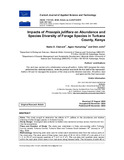| dc.contributor.author | Nadio, E. Clement | |
| dc.contributor.author | Agevi, Humphrey | |
| dc.contributor.author | Obiri, John | |
| dc.date.accessioned | 2021-12-31T08:30:27Z | |
| dc.date.available | 2021-12-31T08:30:27Z | |
| dc.date.issued | 2020-11-05 | |
| dc.identifier.uri | https://doi.org/10.9734/CJAST/2020/v39i3331026 | |
| dc.identifier.uri | https://www.journalcjast.com/index.php/CJAST/article/view/31026 | |
| dc.identifier.uri | http://ir-library.mmust.ac.ke:8080/xmlui/handle/123456789/1944 | |
| dc.description.abstract | Aims: This study sought to determine the effects of P. juliflora on the abundance and relative diversity of other forage species in Turkana County.
Study Design: Ecological data collection entailed cross-sectional surveys across riverine and non-riverine ecosystems.
Place and Duration of Study: The study was undertaken in three sub-counties within Turkana County namely Turkana Central, Turkana West and Turkana South between 15th January to 17th May, 2020.
Methodology: Sampling plots were used to collect plant abundance data from the various parts of the study area. The plots were of three types; main plots of 30 m× 40 m (1200 m2), sub-plots of 5 m × 2 m (10 m2) and square quadrats of 1 m×1 m (1 m2). The sub-plots and quadrats were nested within the main plots which were in turn laid down along transect belts. The transects of width 40 m and 400m in length were laid down in two main habitats (riverine and non-riverine) of the three sub-counties. Control plots were also laid in non P. juliflora sites.
Results: Prosopis juliflora was the most abundant species covering about 63% of the sampled individuals (N=6390). This was followed by Acacia tortilis at 18% while Acacia mellifera was the least. There was significant difference in abundance between sites and among counties (p˂0.05). The Shannon diversity index (H´) in areas with Prosopis juliflora ranged between 0.40-1.27 while in areas without Prosopis juliflora (or Control) it ranged between 1.5-2.1, indicating high diversity in the areas without P. juliflora compared to areas colonized by it. Prosopis juliflora was also high in the riverine areas compared to non-riverine areas across the three sub counties. Results show that Prosopis juliflora has invaded vast areas especially the riverine ecosystem leading to a decline in the population of key forage species and thus threatening the socio-economic livelihoods of Turkana County.
Conclusion: Prosopis juliflora was the most abundant and dominant plant species in both the riverine and non-riverine sites. The study also showed that P. juliflora has led to the decreased plant species richness and diversity in the area because of its invasive nature. | en_US |
| dc.language.iso | en | en_US |
| dc.publisher | Current Journal of Applied Science and Technology | en_US |
| dc.subject | Impacts, Prosopis, juliflora, Abundance, Species, Diversity, Forage | en_US |
| dc.title | Impacts of Prosopis juliflora on Abundance and Species Diversity of Forage Species in Turkana County, Kenya | en_US |
| dc.type | Article | en_US |

